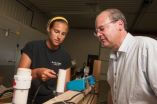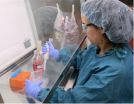(Press-News.org) MANHATTAN, KAN. -- A group of Kansas State University researchers has made valuable findings in the search for cancer's cure.
While researching ways to improve animal health, the scientists -- Raymond "Bob" Rowland, a virologist and professor of diagnostic medicine and pathobiology, and Deryl Troyer, professor of anatomy and physiology --have made two important discoveries that can also improve human health. Not only have they found pigs with severe combined immunodeficiency, or SCID, but they are also the first to discover the connection with human cancer, particularly melanomas and pancreatic cancers.
The researchers call it a scientific achievement with huge potential to improve surgeries and drug development involved with cancer.
"This could be a game-changer," Troyer said.
It began with Rowland's research with controlling and eliminating porcine reproductive and respiratory syndrome, or PRRS. The work led to a fortuitous discovery: a naturally occurring line of immunodeficient pigs.
"Pigs are closely related to humans anatomically and physiologically," Rowland said. "This can have huge potential for human cancer research."
After the discovery of SCID pigs, Rowland turned to Troyer, who performs cancer research. Their collaborative work not only enables researchers to better study SCID pigs, but they can also apply their research to the study of human cancer and anti-cancer drugs.
"This is a great example of collaborative and interdisciplinary research," Troyer said. "With two perspectives, there is often a synergy that evolves because of different ways of thinking."
The researchers have already studied human melanomas and human pancreatic cancers, which are devastating types of cancer and a big target in cancer research, Troyer said. They want to apply the same methods to other types of solid cancers and blood neoplasms like leukemia.
While similar research has been performed with SCID mice, it has not adapted well to human cancer research. Rowland said there is about a 90 percent failure rate in translation of results from mice to humans. Research involving SCID pigs may be more beneficial to human cancer research because pigs are closer anatomically to humans.
The research opens a variety of doors for both animal and human health research. It may now be easier for scientists to improve strategies for bone marrow transplants. They also have a better way to detect cancer drug side effects and test surgical interventions, Troyer said.
"The potential is a little daunting because it is as if there is no horizon limiting possible ways to utilize this model, " Troyer said. "It is an opportunity for Kansas State University to be a leader in the field and to become a center for large animal biomedical research."
For Rowland, the discovery also opens new doors for infectious disease research.
"There are a lot of pig diseases for which we still don't know how they function and how they cause disease," Rowland said. "Now we are able to ask the question, 'What role does the immune system play in clearing the virus or in causing disease?'"
The research also improves the study of zoonotic diseases, which are diseases -- like swine influenza -- that can be transmitted between animals and humans. By developing vaccines for diseases in SCID pigs, scientists can gain insight into human vaccine development. The university's Biosecurity Research Institute provides the ideal location for developing these vaccines, Rowland said.
The scientists have performed research on a small scale and now want to build it up to a larger scale. They see possibilities for new research with the Kansas State University Johnson Cancer Research Center as well as cancer research partnerships and collaborations with the University of Kansas Cancer Center, especially with its recent National Cancer Institute designation.
"Agriculture benefits the people of the state in so many ways," Rowland said. "While it includes jobs and exports, there is a human element that we sometimes forget. This is a good example of how we can take animal health research and all of a sudden it has the potential to help cure human cancer."
The research recently appeared in the journal BioResearch Open Access. Rowland and Troyer have another upcoming publication in the Journal of Veterinary Pathology.
INFORMATION:
The College of Veterinary Medicine has provided financial support for the research. Other university collaborators include the Comparative Medicine Group, Stefan Bossmann, professor of chemistry, and Duane Davis, professor of animal sciences and industry. Researchers at Iowa State University were also involved.
END
Dieters often use online calorie calculators to stay true to their weight-loss plan. Translating the concept to the population health arena, researchers at Columbia University's Mailman School of Public Health created the Caloric Calculator to help policymakers, school district administrators, and others assess the potential impact of health policy choices on childhood obesity.
Select a target population (middle-school-age boys, for example) and the Caloric Calculator tells you the percentage of this group who are obese (18%) and the average daily calorie cuts necessary ...
WASHINGTON, Aug. 15, 2012 — The latest episode in the American Chemical Society's (ACS') award-winning Global Challenges/Chemistry Solutions podcast series describes a potential new approach for treating urinary tract infections (UTIs) — which affect millions of people annually — without traditional antibiotics. Because it involves non-antibiotic compounds, the approach would not contribute to the growing problem of antibiotic-resistant bacteria, or "superbugs."
Based on a report by Beat Ernst, Ph.D., and colleagues in ACS' Journal of Medicinal Chemistry, the new podcast ...
WASHINGTON, Aug. 15, 2012 — Progress toward developing an alternative to organ transplantations in which doctors could actually grow a new heart or liver for a patient is among the topics in the 2012 premier of a popular video series from the American Chemical Society (ACS), the world's largest scientific society. The videos are available at www.acs.org/PrizedScience and on DVD.
Titled Prized Science: How the Science Behind American Chemical Society Awards Impacts Your Life, the first episode of the 2012 series features the research of Dr. Robert Langer, winner of the ...
VIDEO:
This computer animation, created using new software called Arepo, simulates nine billion years of cosmic history. Arepo can accurately follow the birth and evolution of thousands of galaxies over billions...
Click here for more information.
Scientists at the Harvard-Smithsonian Center for Astrophysics (CfA) and their colleagues at the Heidelberg Institute for Theoretical Studies (HITS) have invented a new computational approach that can accurately follow the birth and ...
EAST LANSING, Mich. — A professor at Michigan State University is part of a team developing a new method of removing phosphorous from our wastewater – a problem seriously affecting lakes and streams across the country.
In addition, Steven Safferman, an associate professor of biosystems and agricultural engineering, and colleagues at Columbus, Ohio, based-MetaMateria Technologies, are devising a cost-effective way of recovering the phosphorous, which then can be reused for fertilizer products.
Although its use is regulated in many states, including Michigan, in items ...
In public comments submitted yesterday, People for the Ethical Treatment of Animals (PETA) applauds the United States Department of Agriculture (USDA) Center for Veterinary Biologics (CVB) for announcing its plans to allow firms to secure exemptions from the target animal batch safety tests (TABST) that have until now been required for each batch of veterinary biologics products, including live and inactivated vaccines. In draft memorandum 453, USDA states that CVB intends to consider TABST exemptions in line with recommendations in the TABST waiver guideline drafted by ...
Amid policy debate over potential liquefied natural gas (LNG) exports from the United States, a new paper from Rice University's Baker Institute for Public Policy predicts the long-term volume of exports from the U.S. will not likely be very large. The paper also argues that the impact on U.S. domestic natural gas prices will not be large if exports are allowed by the U.S government.
Significant changes in the global gas market in the past decade, particularly the emergence of shale in North America, have dramatically altered the global outlook for LNG markets and ...
Amsterdam, NL, August 15, 2012 – In a study published in the current issue of Restorative Neurology and Neuroscience scientists report that a therapy combining exercise with the neurovascular protective agent S-nitrosoglutathione (GSNO) improved recovery from stroke in a rat model. GSNO is a compound found naturally in the body and it has no known side effects or toxicity.
"In our study, GSNO or motor exercise provided neuroprotection, reduced neuronal cell death, maintained tissue structure, and aided functional recovery by stimulating the expression of neuronal repair ...
The World Health Organization estimates that in 2011 there were 216 million cases of malaria and 34.2 million people living with HIV. These diseases particularly afflict sub-Saharan Africa, where large incidence of co-infection result in high mortality rates. Yet, in spite of this global pandemic, interactions between the parasite that causes malaria, Plasmodium falciparum, and HIV-1 are poorly understood. However, a new video article in JoVE, the Journal of Visualized Experiments, that describes a novel technique to study the interactions between HIV-1 and P. falciparum ...
BOSTON--The genomic tumult within tumor cells has provided scientists at Dana-Farber Cancer Institute and the Broad Institute of MIT and Harvard with clues to an entirely new class of genes that may serve as an Achilles' heel for many forms of cancer.
As reported in the Aug. 17 issue of the journal Cell, the researchers identified 56 such genes, only a few of which had previously been identified as potential targets for cancer therapy. Unlike most such targets, these genes don't cause normal cells to turn cancerous. Instead, they are essential to all cells but have been ...



